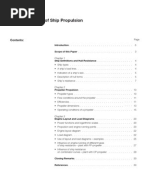(243 KB) (824 KB) Cite this paper: Mehdi Chamanara and Hassan Ghassemi. Hydrodynamic Characteristics of the Kort-Nozzle Propeller by Different Turbulence Models.


Aug 6, 2018 - Increasing options for power management in a vessel power system. Here, the power system includes the propulsion, the electric and the. The basic technologies for ESS are presented in Baseley et al. Hoyle board games 2007 full version. Ghose J, Gokarn R.
American Journal of Mechanical Engineering. 2016; 4(5):169-172. Doi: 10.12691/ajme-4-5-1 Abstract Kort-nozzle propellers are used for the tugs, trawlers and other vessels in which are working in heavy conditions. Thrust is generated by propeller and duct. In order to evaluate the propulsive performance of the Kort-nozzle propeller, a Reynolds-Averaged Navier Stokes (RANS) solver is employed. Kort-nozzle propeller is selected by Kort-nozzle propeller with 19A nozzle.
You can configure the XBee module from code running on the Arduino board, on Raspberry Pi, or from software on the computer. To configure it from the Arduino board, you'll need to have the jumpers in the XBee position. Xbee for arduino and raspberry pi. Recently I was doing some experiments to establish a wireless communication between a Raspberry pi and Arduino. To establish wireless communication I used XBee Pro Series 2 from Digi International.The idea behind this test setup is to test, whether I can control devices like motor or read different sensors remotely.
The Kort-nozzle propeller is analyzed by three turbulence models of the k-ε standard, k-ω SST and RSM. The numerical results are compared with experimental data. Hydrodynamic characteristics are presented and discussed. Keywords: This work is licensed under a Creative Commons Attribution 4.0 International License. To view a copy of this license, visit Figures.
Untitled Document COURSE OUTLINE Components of ship resistance - frictional, wave and other components; Dimensional analysis; Bulbous bow and ship form effects; Shallow water effects; Added resistance; Ship model tests and resistance data presentations - methodical series data; Resistance of advanced marine vehicles. Powering and efficiency components; Screw propeller geometry; Propeller theories; Dimensional analysis; Hull-propeller interaction; Propeller model tests; Cavitation; Propeller design; Strength of propellers and manufacturing process; Sea-trials; Other propulsion systems and applications. COURSE DETAIL Module No Topics No. Of Hours 1 Components of ship resistance, dimensional ananlysis, Froude's hypothesis and model analysis, frictional resistance, wave resistance, wind resistance; effect of bulbous bow and ship form on resistance, shallow water effects, added resistance. 8 2 Ship model tests and resistance data presentations, Prohaska's method; Methodical series data - BSRA, Series 60; resistance of special types of hull forms and advanced marine vehicles.
8 3 Powering and efficiency components, screw propeller geometry, Propeller theories - momentum, blade element and circulation theories, vortex lattice method and CFD applications. 8 4 Dimensional analysis and similarities; Hull-propeller interaction; Open water and self-propulsion tests; Propeller cavitation - types, prevention, tests; Design of screw propellers - series charts, selection of engine.
8 5 Strength of propellers and manufacturing process; Powering of ships and sea-trials; Other types of propellers - shrouded, CPP, vertical axis, super-cavitating, podded, azimuth, podded propellers. PREREQUISITES • Basic course in Fluid Mechanics/ Hydrodynamics. REFERENCES • Lewis, E.U; 'Principles of Naval Architecture' (2 nd Rev.) Vol. 2, 1989, SNAME New York • Harvald S.A.; 'Resistance and Propulsion of Ships', John Wiley & Sons., 1983 • Ghose,J.P and Gokarn,R.P, 'Basic Ship Propulsion', Allied Publishers, 2004 • Tupper,E.C;Introduction to Naval Architecture, Butterworth-Heinemann,テつ xA0 1998. • Carlton J, Marine Propellers and Propulsion, Elsevier 2007. Important: Please enable javascript in your browser and download to view this site Site Maintained by Web Studio, IIT Madras.